C.1610
Rubber tyres
Any vehicle is pulled down by the earth’s gravitational field. To stop it from falling, the vehicle must be supported through contact with its surroundings, and for different kinds of vehicle the area of contact has a characteristic size and shape depending on the materials involved. For example, the wings of an aircraft are supported by a difference in air pressure between the upper and lower surfaces whose area extends to many square metres. By contrast, a railway vehicle has steel wheels that travel on steel rails: the materials are hard and the area of contact is only a few millimetres across. But what about road vehicles? They rely on rubber tyres and for much of the time travel on asphalt roads whose constituents are glued together with bitumen. The curious thing about rubber and bitumen is that both are viscoelastic: neither solid nor liquid but somewhere in between. Materials of this kind are more common than you might imagine: for example, toothpaste and butter are viscoelastic, together with clay and glass. But perhaps because they don’t conform to the physical models used to describe a gas, a liquid, or a solid, it is only within the last few decades that their behaviour has been systematically explained.
Characteristics of rubber
Chemically, rubber is a polymer of isoprene. Like all polymers, it consists of basic units linked together in chains. By ‘chains’ we mean very long chains indeed: typically 60,000 units. The basic unit contains five carbon atoms and eight hydrogen atoms and is represented by the chemical formula C5H8. In addition, every 4th unit in the chain carries a methyl (CH3) side group [16].
Molecular structure
The chains are not aligned in parallel rows but rather each molecule curls into a ball with no regular geometrical structure. In isolation, each molecule can coil and can uncoil freely, but unlike a molecule in a true liquid, its freedom is constrained by cross-links to its neighbouring molecules [1]: the junctions give rubber a coherent structure. They are created through vulcanisation, a chemical reaction involving sulphur that was discovered by Charles Goodyear in 1839 [17].
This coiled molecular structure allows rubber, uniquely among all materials, to stretch to several times its original length and return to its original shape when released. But why do the molecules curl up in the first place? The generally accepted theory of rubber elasticity that arose during the 1930s starts with the fact that long-chain atoms vibrate at right-angles to their length. So if you stretch a chain, the impacts from neighbouring molecules tend to knock the centre out of line (figure 1). Displacement of the centre in turn draws the ends together like the edges of a curtain when pleated by a curtain cord. If you let go of the ends, the molecule will contract until the impacts from its neighbours no longer have a resultant directional effect.
Figure 1
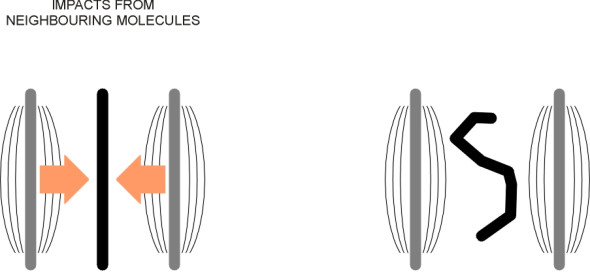
Stress and strain
If we want to understand the structural character of an everyday object such as a length of copper wire, we might subject it to a particular load (say 10 kilograms in tension) and observe how much the wire stretches in millimetres: we observe the relationship between load and extension. But for comparing objects of different size and shape it is more useful to think in terms of stress and strain. Stress measures the load per unit of cross-sectional area in units of newtons per square metre say, and strain the extension divided by the total length, which is dimensionless. The stiffness, also known as the modulus of elasticity, is then the ratio of the two. This makes it possible to compare like with like: the loading regime for a piano string and a ship’s cable are reduced to the same common framework. This becomes clear if we consider string and cable broken down into particles all of the same size and shape, for example 0.1 mm cubes. Then if the stresses are equal, the load on each particle of the string and the load on each particle within the cable are the same. Similarly, if the strains are equal, then each particle is stretched by the same amount. From a particle’s point of view, it makes no difference whether it is part of a piano or part of a ship.
For practical purposes we regard a ‘normal’ material like steel as a geometrically rigid structure. Its shape is fixed by atomic forces holding the constituent molecules together. It takes a large force to stretch them, so steel has a high modululus of elasticity, around 2 \(\times\) 105 MNm\(^{-2}\) or 200 GPa. Moreover the bonds will only stretch a little so the material cannot be distorted by more than 10% without irreparable damage. In fact most metals behave similarly because their molecules are arranged in a regular crystal structure, and when the stress reaches a critical level they don’t break so much as yield, with the plates of molecules sliding over one another. The crystals become ductile, flowing like a stiff molten liquid before the specimen finally breaks.
Non-metallic substances tend to break rather than yield. They are broadly classified as ‘brittle’, and while this may seem a strange description, rubber, like ceramics, comes into this category. What makes rubber unusual is the degree of strain it will tolerate before breaking, together with its S-shaped stress-strain curve (a picture of this curve can be found in [3]), and its very low stiffness - less than 0.01 GPa at the origin.
Viscoelastic properties
In fact, rubber belongs to a class of materials that can be thought of as lying somewhere between a solid and a viscous liquid: they exhibit viscoelasticity. Animal tissue of all kinds, butter and glass are among the viscoelastic materials that our distant ancestors encountered in their daily lives. Viscoelastic polymers have been with us for about a hundred years. But it’s only quite recently that science has developed a theory that explains their behaviour, and with these scientific models came the realisation that the distinction between ‘solid’ and ‘liquid’ is to some extent artificial: almost any materials will flow like a liquid if you are prepared to wait long enough.
Some of the properties of rubber are familiar from everyday experience, while others are bizarre:
- Its thermal behaviour, like that of many other polymers, is unusual: for example, it shrinks when it gets warmer and expands when the temperature falls – the opposite of what happens with ‘normal’ materials.
- Rubber is not squashy at all temperatures. Natural rubber, for example, goes hard when cooled to a temperature of -71\(^\circ\)C. This temperature is known as the Glass Transition Temperature. The geometrical structure is not immediately affected, but if kept at a low temperature for a long time, the material will gradually crystallise [18].
- Rubber bounces. This is because it deforms to a much greater degree than other materials, but after the stress is removed it recovers its original shape. When other materials undergo a comparable collision, they don’t deform very much, so the stresses are concentrated over a smaller area of impact. These stresses cause local damage, and much of the kinetic energy goes into fracturing the material.
- Rubber flows like a liquid: a phenomenon usually described as ‘creep’ because it occurs very slowly over a long time scale. Hence if a car is left parked for too long, the tyres will develop flat spots [2].
- Rubber is almost incompressible in volume terms. You can deform it in many different ways but its volume remains almost unchanged throughout. If you enclose a specimen within a steel tube so it can’t swell in the middle, it behaves like a rigid block: you can apply considerable pressure to the ends of the specimen but it won’t contract (figure 2).
- Like any viscous liquid, rubber dissipates energy on deformation, so that when a rubber ball bounces, some of its kinetic energy is converted into heat. At room temperature, for both natural rubber and synthetics the proportion dissipated is between 40% and 60% [19].
This last property is vital because it explains why rubber tyres grip the road in wet weather. When a car brakes, the tyre tread ‘creeps’ over the particles of stone that protrude from road surface, and undergoes a loading and unloading cycle as it passes over each protrusion. Because of energy dissipation during each cycle, the contact pressure of the rubber with the upstream face of each protrusion is higher than the corresponding value when it unloads on the downstream face. The pressure difference provides a net braking force regardless of whether there is any friction between the two materials (see Section C1717).
Figure 2
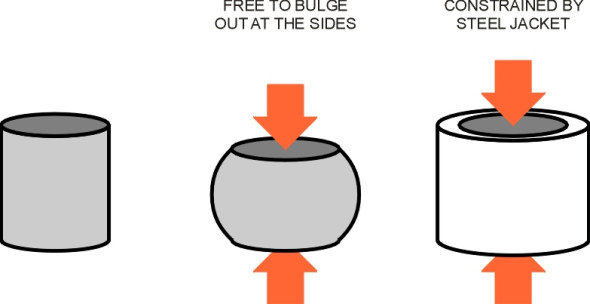
The tread
In fact the most important design requirement for a pneumatic tyre is its performance in the rain. While a worn tyre will perform just as well as a new tyre on a dry surface, its grip falls dramatically in wet weather. The reason for the loss of grip, which often takes drivers by surprise, is not because the rubber is too thin, but because the grooves are too shallow.
Pumping water
In order to make use of hysteresis grip, it’s essential to pump water away from the contact patch so that a wedge of fluid doesn’t build up under the leading edge. It is the formation of a wedge that leads to aqua-planing, a condition in which the tyre lifts clear of the road surface texture and the friction falls to zero (see Section C1603). At a speed of 60 km/h on a perfectly smooth surface carrying a water film of depth 2.5 mm , a tyre whose contact patch is 120 mm wide must pump 5 litres of water per second out of the wheeltrack to maintain full contact between the tyre and the road.
The groove pattern
This is the function of the groove network on the tyre tread. The pattern appears in a bewildering variety of designs produced by different manufacturers, but they all conform to the same principles [9]. Most of the water squirts out from the rear of the contact patch via grooves around the tyre circumference. Transverse grooves are also present, but they are less effective on wide tyres because of the comparatively long exit route to either side. The transverse grooves have another function: together with the longitudinal grooves they break up the tread into rectangular or diamond-shaped blocks. When it meets a projection in the road surface, each block wipes off some of the water film, as well as gaining friction from a degree of mechanical interlock with the projection. However, transverse blocks tend to wear quickly at the leading and trailing edges, and a similar effect can be achieved with less wear by modifying the circumferential grooves into a zig-zag pattern. A final stage of water removal is carried out by sipes, which are narrow fissures cut into the tread blocks.
Sketches of different tread patterns used on tyres suitable for different type of road can be found in most books on road vehicle technology (for exampl [8] [14]). Not always apparent from the illustrations is the fact that unlike domestic wallpaper, where the decorative pattern is repeated at fixed intervals, the tread pattern is not regular. The reason is that that regular impulses can trigger a natural frequency of vibration in the suspension or bodywork that will be perceived as noise or vibration in the passenger compartment. Tyre tread patterns are slightly random.
Riding on air?
As well as providing grip, a tyre will also act as a suspension system in its own right, because it cushions the vehicle from some of the high frequency vibrations before they reach the main suspension spring and damper system. But a pneumatic tyre can easily be punctured, which at worst can cause a crash, and at best disables the vehicle until the wheel can be changed. Would not a solid rubber tyre work just as well?
Solid tyres
The answer is that solid tyres do not deform in the same way as air-filled ones, and in consequence give a relatively rough ride. It doesn’t matter how flexible the rubber might be, its volume is more-or-less fixed, so that when pressed down on a hard surface, the tread can deform only if the core deforms as well. The whole cross-section of the tyre moves, bulging out on either side. Since deforming rubber in this way requires more effort than deforming air, a solid rubber tyre does not absorb road surface roughness as readily as a pneumatic tyre. It has a higher stiffness, and this leads to another problem that if anything is more serious than a bumpy ride. Since the tread does not deform easily, it doesn’t form a large contact patch where it meets the road surface, and the grip is correspondingly poor.
Pneumatic tyres
Unlike a solid tyre, when a pneumatic tyre is squeezed, the air in the part of tube that is being deformed can easily move out of the way, redistributing itself quickly around the whole tube. In fact, many years ago, tests showed that the internal pressure changes very little with impact on road surface irregularities, typically less than +/- 1% [7]. So the elasticity of a pneumatic tyre enables a more comfortable ride.
This raises an intriguing question. What stops the wheel from sinking down until the rim is rolling along the road surface? It can’t be held up by the air pressure inside, at least not directly, because the air pressure is the same at all points around the rim, pressing down on top of the rim with the same force as it presses up from below (figure 3). The load must therefore be carried by the tyre wall. It’s not a matter of compression. The rim can’t rest on the tyre wall, because the wall is too thin to support a heavy load (figure 4). It has to be tension. It works in the same way as the spokes of a bicycle wheel, which pull radially outwards on the hub and radially inwards on the rim. It’s the difference in tension between the spokes at the top and the spokes at the bottom that accounts for the support given to the rider and the bicycle frame. The same applies to the walls of a pneumatic tyre [21]; see figure 5). The load path passes through the upper half of the tyre carcass not the lower half, so the weight of the car hangs from the upper tyre wall.
Figure 3
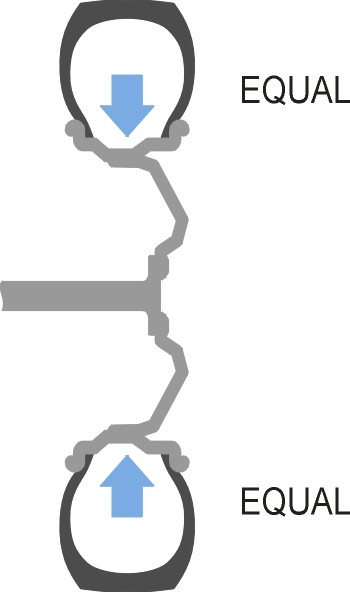
Figure 4
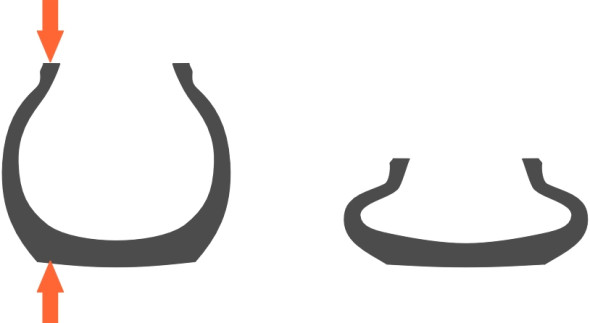
Figure 5
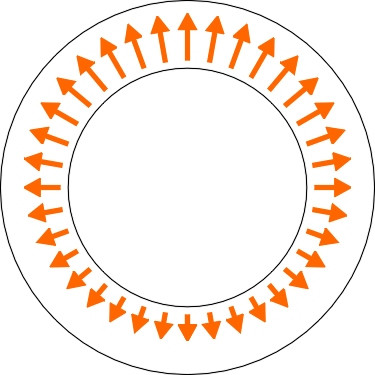
But this still doesn’t look right. If the rim pulls downwards on the upper tyre wall surely the wall will separate from the rim and the air will escape? This is where the bead core comes in: a bundle of steel wires that stops the bead from stretching and binds it tightly to the rim. In fact, the bead core bridges the gap by carrying the load in tension from the bottom of the rim to the tyre wall at the top. The two walls hang down from either side of the tread at the top of the tyre like saddlebags over a donkey. What keeps them up is the body of compressed air inside, which transmits the load in compression back down again, to dissipate into the road through the contact patch. The complete load path is sketched in figure 6, where you can see that the whole weight of the axle effectively hangs on the two bead wires. For a heavy lorry with a wheel load of 5 tonnes, the tension in each bead wire is 1.25 tonnes.
Figure 6
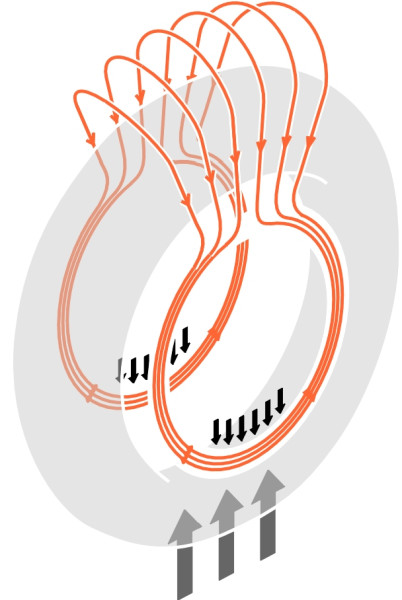
Construction of pneumatic tyres
Early rubber tyres were easily punctured and had a short life, so that motorists were often obliged to stop and repair them. On the other hand, pneumatic tyres gave a better ride than anything else and were therefore in great demand – so much so that tyre production became a profitable industry in its own right. Competition was intense, and manufacturers courted publicity from motor racing, as described by Herbert Lottman in his biography of the Michelin brothers André and Edouard [10]. Since those early years, continued investment in materials and production technology has led to car tyres that are vastly more reliable and long-lasting than their predecessors. Today, punctures are less frequent, so the spare wheel is not often needed, and cars are provided with a lightweight version for use in emergencies only. Some manufacturers would like to dispense with the spare wheel altogether.
Materials
The various parts of a modern radial tyre are shown in figure 7. Only about a third of a modern tyre by weight is actually rubber [5], and it is synthetic rubber rather than natural rubber, created chemically from oil stock. Another third consists of carbon black and oil ‘extenders’ that reduce the viscosity of the rubber and make it easier to mould, and the remaining third steel wire and polymer cord reinforcement. Early tyres were expensive and only lasted 2000 miles. They were made from natural rubber which gave them a light grey colour; it is the carbon filler that makes modern tyres look black. Introduced by Pirelli in 1907, carbon black improved tread life by a factor of two or three [4], and improvements continued over many decades through to the 1950s, when car tyres were expected to have a life of 30,000 miles [15]. Their durability doesn’t seem to have improved since, but this may be because traffic speeds and wheel loads are much greater now than they were fifty years ago.
Figure 7
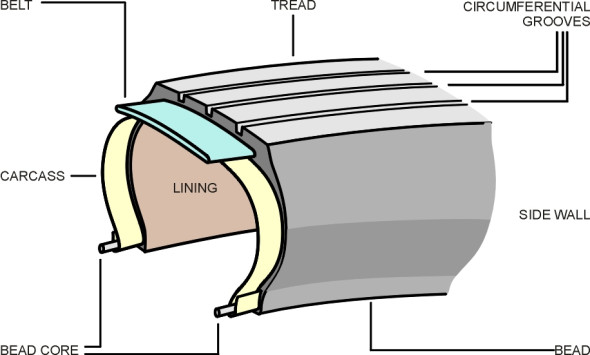
Reinforcement
Tyres are heavily reinforced so they keep their shape while cornering and resist damage from rough roads. At first, the reinforcing fibres were made from natural fabrics and then synthetic cord. Steel wire was an obvious candidate but it tended to work loose from the rubber matrix. An important step in reducing the frequency of punctures and blow-outs was the discovery in the 1930’s that steel wire would bond to the rubber matrix if first coated with brass. Steel wire is now used around the circumference of car tyres, in combination with (for example) rayon reinforcement in the tyre walls.
Figure 8
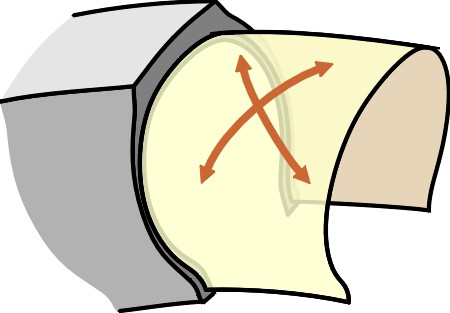
Modern tyres are called radial tyres to differentiate them from traditional cross-ply or bias-ply tyres that are still used on heavy lorries and motorbikes. A bias-ply tyre is U-shaped in cross-section, with textile reinforcing plies that run from bead to bead arranged in alternate layers so the fibres cross at roughly 90\(^\circ\) (figure 8). As far as the reinforcement structure is concerned, there is no distinction between the tyre wall and tread, so the cross-section has only moderate resistance to distortion when pushed to one side, as occurs when the vehicle goes round a curve. Even when travelling in a straight line, the tread distorts in plan as it passes through the contact patch, a phenomenon known as ‘squirm’. By contrast, a radial tyre is made with a flat belt around the outside, which separates the function of road-holding from that of providing a comfortable ride (figure 9). The reinforcement in the belt is not actually circumferential, but aligned at an angle of 18\(^\circ\)-22\(^\circ\) to the circumference [20]. The sidewall plies are aligned radially, and the reinforcement is relatively light so the walls can flex easily. Because the tread acts as a cylinder rather than a torus, it resists distortion in cornering, and thereby constrains the slip angle (see Section C1717), which in turn makes the tyre directionally stiffer and more responsive (figure 10). The tread is wider with a larger contact patch, which in turn provides more grip, permits lower inflation pressures, and leads to a smoother ride with less wear.
Figure 9
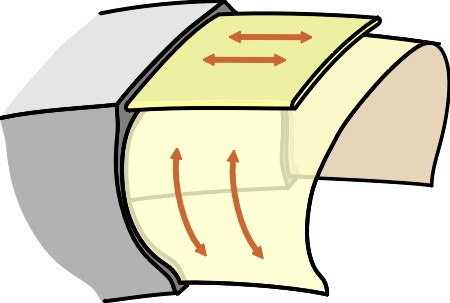
Figure 10
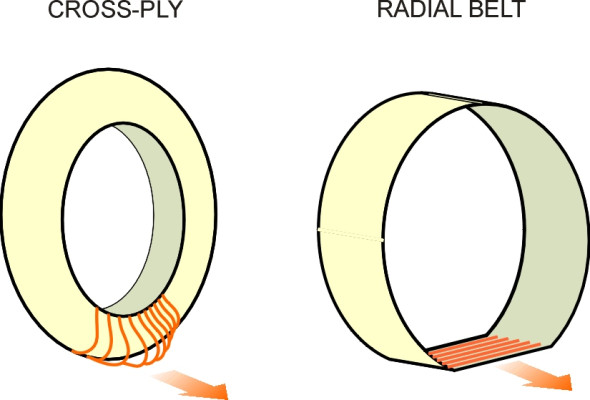
Finally, since the walls flex more readily than those of a cross-ply tyre, the radial tyre offers less rolling resistance. But there is potential to reduce it further by altering the chemistry of the material, and also by narrowing the tread. A narrow tread is quite effective, although it would appear to compromise the handling qualities somewhat. These possibilities are explored further in Section G1619.
Tubeless tyres
The tubeless tyre was originally developed by Frank Herzegh of the Goodrich Company in 1947 [6] [11], and it is now the automatic choice for almost all cars because it is lighter than a tubed tyre of comparable strength and does not generate heat from friction between the inner and outer envelopes. You might wonder why the air doesn’t leak out between the tyre bead and the wheel rim; a sealing lip is provided around the bead, and because the seating on a car wheel is tapered at 5\(^\circ\), the bead is forced to climb and wedge in close contact with the rim. In addition, the inner surface of the tyre is lined with a soft rubber coating that is less permeable to air than a standard inner tube. This means that the pressure in a tubeless tyre falls by only 25-30% per annum [13], and the tyre is less likely to burst when punctured because minor punctures seal themselves before serious damage can be done. Even if the puncture is severe, the tear does not grow rapidly in size as it does with a tubed tyre. Unfortunately, you can’t fit tubeless tyres on ordinary bicycle wheels because the air would leak through the metal rim around the spoke attachments; for the same reason, many commercial vehicles continue with tubed tyres because the wheels are two-piece and do not seal.
Conclusion
Depending on your point of view, pneumatic tyres are a nuisance. The air pressure must be topped up and the tread checked regularly. Tyres are liable to be punctured, they wear out more quickly than most other parts of the vehicle, and they are costly to replace. On the other hand, it has been said that the pneumatic tyre does its job uniquely well, developing a much higher cornering force than any other known structure [12]. It is hard to imagine a viable substitute appearing in the market within the next few years. While other parts of the car – the engine, the body materials, and the control systems – are changing radically to cope with new demands, the pneumatic tyre seems likely to continue in its present form while the rest of the vehicle evolves around it.